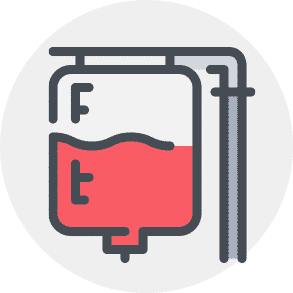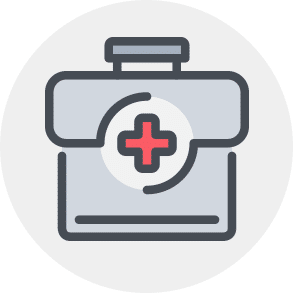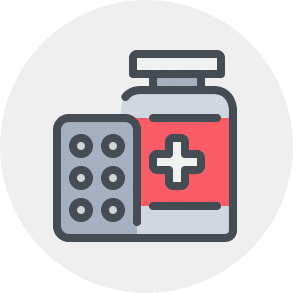¿Necesita un Plan accesible
De la Parte D de Medicare?
Encuentre un plan accesible de la Parte D de Medicare que sea adecuado para usted.
¿Necesita un Plan accesible
De la Parte D de Medicare?
Encuentre un plan accesible de la Parte D de Medicare que sea adecuado para usted.
PLANES DE MEDICAMENTOS CON RECETA (PARTE D)
¿QUÉ ES MEDICARE PARTE D?
La cobertura de medicamentos recetados de la Parte D de Medicare, a menudo denominada Parte D, está disponible a través de aseguradoras privadas para cualquier persona que también sea elegible para Medicare Original y resida permanentemente en el área de servicio de un plan de medicamentos recetados de Medicare. Las diferentes aseguradoras ofrecen diferentes tipos de planes, por lo que su prima y los gastos de bolsillo por medicamentos recetados variarán. La Parte D de Medicare es una cobertura de medicamentos recetados. Puede obtener la cobertura de la Parte D de Medicare a través de un plan de medicamentos con receta de Medicare independiente o un plan de medicamentos con receta de Medicare Advantage. Ambos están disponibles en compañías de seguros privadas aprobadas por Medicare.
La cobertura de la Parte D de Medicare es opcional, pero si no se inscribe en la Parte D de Medicare tan pronto como sea elegible, es posible que deba pagar una multa por inscripción tardía si se inscribe más tarde. La prima mensual del plan y los gastos de bolsillo por medicamentos recetados variarán de un plan a otro.
¿QUÉ ESTÁ CUBIERTO?
La Parte D de Medicare cubre sus medicamentos recetados. Cada plan privado ofrecido a través de la Parte D debe proporcionar un nivel estándar de cobertura establecido por Medicare. Los requisitos significan que la mayoría de los planes tienen formularios considerables con la capacidad de recetar medicamentos para muchas enfermedades. Las compañías de seguros privadas tienen control sobre los medicamentos que cubren y los "niveles" que afectan el costo. Consulte nuestra guía de cobertura de la Parte D de Medicare para obtener más información.
¿QUÉ MÁS DEBE SABER SOBRE LOS PLANES DE MEDICAMENTOS CON RECETA PARTE D DE MEDICARE?
Independientemente del tipo de plan de medicamentos recetados de Medicare que tenga, aquí hay algunas cosas que debe tener en cuenta.
- Si el plan tiene un deducible anual, por lo general, paga el monto total de sus compras de medicamentos recetados hasta que se alcanza el deducible.
- Después de cumplir con el deducible anual, pagará una parte de los costos de acuerdo con los términos de su plan. Su parte, que normalmente paga a la farmacia en el momento de la recogida, podría ser una cantidad fija (copago) o un porcentaje de la cantidad total (coseguro).
- Si usted y su plan gastan $ 4,020 combinados en 2020 (un monto llamado límite de cobertura inicial), ingresará a una fase de cobertura de la Parte D de Medicare diferente. Durante esta fase, no pagará más del 25% del costo de cada receta cubierta. El límite de cobertura inicial puede cambiar de un año a otro.
- Una vez que haya pagado una cierta cantidad máxima anual de su propio bolsillo por los medicamentos recetados cubiertos, automáticamente obtiene una “cobertura catastrófica”. Esto significa que durante el resto de ese año en particular, solo pagaría un pequeño copago o coseguro por los medicamentos recetados. La cobertura catastrófica de la Parte D de Medicare comienza cuando haya gastado $ 6,350 en 2020. Esta cantidad puede cambiar de un año a otro.
Asegúrese de hablar con su médico para ver si está tomando los medicamentos de menor costo disponibles para usted. La cobertura específica puede variar de un plan a otro, así que lea atentamente su documentación.
¿QUIÉN ES ELEGIBLE PARA EL SEGURO DE LA PARTE D?
Es elegible para un plan de la Parte D de Medicare si:
- Tiene 65 años o más.
- Tiene una discapacidad calificada por la cual ha estado recibiendo el Seguro de Discapacidad del Seguro Social (SSDI) durante más de 24 meses.
- Se le ha diagnosticado enfermedad renal en etapa terminal (insuficiencia renal permanente que requiere un trasplante de riñón o diálisis).
- Tiene derecho a la Parte A o la Parte B de Medicare.
Debe considerar la Parte D si se inscribe en Medicare Original y:
- Tiene una necesidad regular de medicamentos recetados.
- Tendrá una necesidad de medicamentos recetados en el futuro.
- Tiene problemas para pagar sus necesidades actuales de medicamentos recetados.
- No tiene cobertura de medicamentos recetados.
- Quiere evitar una penalización.
¿CÓMO ME INSCRIBO EN LA PARTE D?
El Período de inscripción abierta para Medicare y la Parte D es del 15 de octubre al 7 de diciembre. Si no compra un plan, entonces puede calificar para un Período de inscripción especial (SEP).
¿NUEVO EN MEDICARE Y PARTE D?
Si se está preparando para inscribirse por primera vez, el período de inscripción inicial de Medicare está abierto durante siete meses. Creemos que es más fácil explicar la inscripción inicial cuando se divide de tres maneras:
- Puede inscribirse en los tres meses anteriores a su 65 cumpleaños. La cobertura comienza el primer día del mes de su cumpleaños.
- Puedes inscribirte el mes de tu cumpleaños. La cobertura comienza el primer día del mes posterior a su cumpleaños.
- Puede inscribirse en los tres meses posteriores al mes de su cumpleaños. La cobertura comienza el primer día del mes posterior a la inscripción. Por ejemplo: supongamos que cumple 65 años el 15 de julio. Su período de inscripción inicial comienza el 1 de abril y finaliza el 31 de octubre.
Por ejemplo: supongamos que cumple 65 años el 15 de julio. Su período de inscripción inicial comienza el 1 de abril y finaliza el 31 de octubre.
¿QUÉ PASA SI EL MEDICAMENTO QUE NECESITO NO ESTÁ CUBIERTO?
Cada plan de la Parte D tiene un formulario. Simplemente, es una lista de los medicamentos cubiertos. Si el medicamento que necesita no está en el formulario, puede solicitar una excepción. Puede ponerse en contacto con el transportista para preguntar si su medicamento tiene un nombre diferente que no reconoce. La Parte D ofrece al menos dos tipos de medicamentos en la mayoría de las categorías y Medicare exige que cubra todos los medicamentos en las seis categorías más esenciales.
COMPARAR PLANES HOY
Llame a un agente de seguros autorizado
1 (877) 255-0284
TTY 711, 24/7
PLANES DE MEDICAMENTOS CON RECETA (PARTE D)
¿QUÉ ES MEDICARE PARTE D?
La cobertura de medicamentos recetados de la Parte D de Medicare, a menudo denominada Parte D, está disponible a través de aseguradoras privadas para cualquier persona que también sea elegible para Medicare Original y resida permanentemente en el área de servicio de un plan de medicamentos recetados de Medicare. Las diferentes aseguradoras ofrecen diferentes tipos de planes, por lo que su prima y los gastos de bolsillo por medicamentos recetados variarán. La Parte D de Medicare es una cobertura de medicamentos recetados. Puede obtener la cobertura de la Parte D de Medicare a través de un plan de medicamentos con receta de Medicare independiente o un plan de medicamentos con receta de Medicare Advantage. Ambos están disponibles en compañías de seguros privadas aprobadas por Medicare.
La cobertura de la Parte D de Medicare es opcional, pero si no se inscribe en la Parte D de Medicare tan pronto como sea elegible, es posible que deba pagar una multa por inscripción tardía si se inscribe más tarde. La prima mensual del plan y los gastos de bolsillo por medicamentos recetados variarán de un plan a otro.
¿QUÉ ESTÁ CUBIERTO?
La Parte D de Medicare cubre sus medicamentos recetados. Cada plan privado ofrecido a través de la Parte D debe proporcionar un nivel estándar de cobertura establecido por Medicare. Los requisitos significan que la mayoría de los planes tienen formularios considerables con la capacidad de recetar medicamentos para muchas enfermedades. Las compañías de seguros privadas tienen control sobre los medicamentos que cubren y los «niveles» que afectan el costo. Consulte nuestra guía de cobertura de la Parte D de Medicare para obtener más información.
¿QUÉ MÁS DEBE SABER SOBRE LOS PLANES DE MEDICAMENTOS CON RECETA PARTE D DE MEDICARE?
Independientemente del tipo de plan de medicamentos recetados de Medicare que tenga, aquí hay algunas cosas que debe tener en cuenta.
- Si el plan tiene un deducible anual, por lo general, paga el monto total de sus compras de medicamentos recetados hasta que se alcanza el deducible.
- Después de cumplir con el deducible anual, pagará una parte de los costos de acuerdo con los términos de su plan. Su parte, que normalmente paga a la farmacia en el momento de la recogida, podría ser una cantidad fija (copago) o un porcentaje de la cantidad total (coseguro).
- Si usted y su plan gastan $ 4,020 combinados en 2020 (un monto llamado límite de cobertura inicial), ingresará a una fase de cobertura de la Parte D de Medicare diferente. Durante esta fase, no pagará más del 25% del costo de cada receta cubierta. El límite de cobertura inicial puede cambiar de un año a otro.
- Una vez que haya pagado una cierta cantidad máxima anual de su propio bolsillo por los medicamentos recetados cubiertos, automáticamente obtiene una “cobertura catastrófica”. Esto significa que durante el resto de ese año en particular, solo pagaría un pequeño copago o coseguro por los medicamentos recetados. La cobertura catastrófica de la Parte D de Medicare comienza cuando haya gastado $ 6,350 en 2020. Esta cantidad puede cambiar de un año a otro.
Asegúrese de hablar con su médico para ver si está tomando los medicamentos de menor costo disponibles para usted. La cobertura específica puede variar de un plan a otro, así que lea atentamente su documentación.
¿QUIÉN ES ELEGIBLE PARA EL SEGURO DE LA PARTE D?
Es elegible para un plan de la Parte D de Medicare si:
- Tiene 65 años o más.
- Tiene una discapacidad calificada por la cual ha estado recibiendo el Seguro de Discapacidad del Seguro Social (SSDI) durante más de 24 meses.
- Se le ha diagnosticado enfermedad renal en etapa terminal (insuficiencia renal permanente que requiere un trasplante de riñón o diálisis).
- Tiene derecho a la Parte A o la Parte B de Medicare.
Debe considerar la Parte D si se inscribe en Medicare Original y:
- Tiene una necesidad regular de medicamentos recetados.
- Tendrá una necesidad de medicamentos recetados en el futuro.
- Tiene problemas para pagar sus necesidades actuales de medicamentos recetados.
- No tiene cobertura de medicamentos recetados.
- Quiere evitar una penalización.
¿CÓMO ME INSCRIBO EN LA PARTE D?
El Período de inscripción abierta para Medicare y la Parte D es del 15 de octubre al 7 de diciembre. Si no compra un plan, entonces puede calificar para un Período de inscripción especial (SEP).
¿NUEVO EN MEDICARE Y PARTE D?
Si se está preparando para inscribirse por primera vez, el período de inscripción inicial de Medicare está abierto durante siete meses. Creemos que es más fácil explicar la inscripción inicial cuando se divide de tres maneras:
- Puede inscribirse en los tres meses anteriores a su 65 cumpleaños. La cobertura comienza el primer día del mes de su cumpleaños.
- Puedes inscribirte el mes de tu cumpleaños. La cobertura comienza el primer día del mes posterior a su cumpleaños.
- Puede inscribirse en los tres meses posteriores al mes de su cumpleaños. La cobertura comienza el primer día del mes posterior a la inscripción. Por ejemplo: supongamos que cumple 65 años el 15 de julio. Su período de inscripción inicial comienza el 1 de abril y finaliza el 31 de octubre.
Por ejemplo: supongamos que cumple 65 años el 15 de julio. Su período de inscripción inicial comienza el 1 de abril y finaliza el 31 de octubre.
¿QUÉ PASA SI EL MEDICAMENTO QUE NECESITO NO ESTÁ CUBIERTO?
Cada plan de la Parte D tiene un formulario. Simplemente, es una lista de los medicamentos cubiertos. Si el medicamento que necesita no está en el formulario, puede solicitar una excepción. Puede ponerse en contacto con el transportista para preguntar si su medicamento tiene un nombre diferente que no reconoce. La Parte D ofrece al menos dos tipos de medicamentos en la mayoría de las categorías y Medicare exige que cubra todos los medicamentos en las seis categorías más esenciales.




